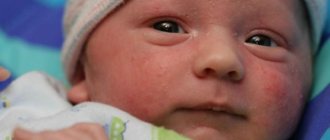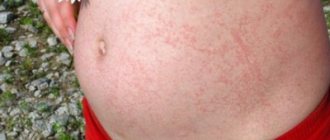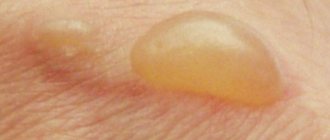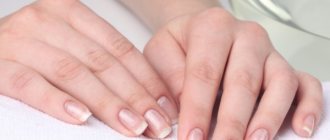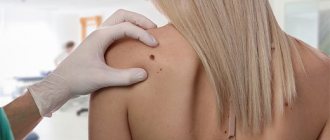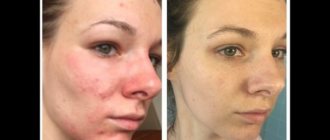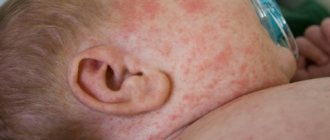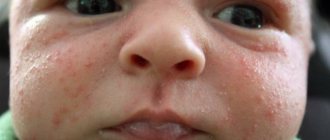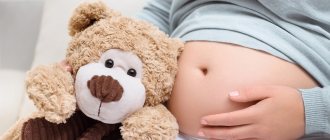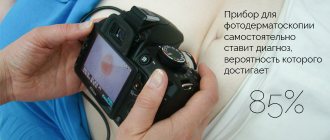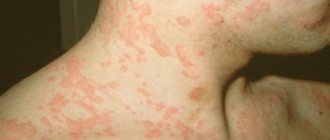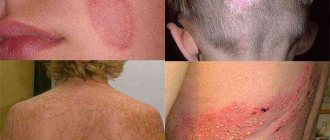New parents examine their baby daily and become nervous if something unknown is discovered. Often we have to deal with the appearance of red spots on the baby’s tender cheeks. This causes anxiety for parents, but it is quite possible to get rid of the problem.
Characteristic rashes can occur for various reasons. Based on them, an effective treatment method is selected.
All spots are divided into 2 main categories: those that do not require specific treatment and those that do need it.
Causes of red dots
Small pimples are a common problem. Sometimes children are born with them, or they begin to appear after 2 weeks of life. Such dots can be of different shades - red, white dots, etc. Usually the nature of their occurrence is harmless, but the problem cannot be ignored.
According to doctors, dots often appear as a result of clogged sebaceous glands.
Tiny white specks located on the surface of the nose and cheeks are called milia or millet specks. They can easily be confused with acne. They appear due to unformed sebaceous ducts. Usually they do not upset the baby and go away on their own within 2 months.
After birth, the baby’s body gradually gets rid of maternal hormones. For the first time, organs begin to independently regulate all body systems. This transition process can affect the appearance of red dot formations.
Parents should be very careful with the areas where the rash occurs. By scraping off spots, a dangerous infection can be introduced into the body.
Pediatricians recommend using calendula-based ointments to treat areas.
Some features of newborn acne
Newborn acne looks slightly different than adult acne. Most often it appears when the child is only a few days old. The rash looks like small bright pink pimples, inside of which a white substance is visible. Acne of newborns has several names - hormonal rash, milia, neonatal pustulosis.
One of the names - hormonal rash - makes it clear what the cause of these skin manifestations is. These are ordinary hormonal changes, the adaptation of the baby’s body to new living conditions, and the cleansing of the mother’s hormones from the blood.
Acne can also be caused by local accumulation of yeast fungus. This is also not considered a pathology; any person has such a fungus. Areas where neonatal pustulosis most often breaks out: upper back, neck, head, face.
Acne does not require treatment; at the age of three months the skin stops blooming without any intervention. Recommendations for parents: do not squeeze pimples under any circumstances, follow all hygiene rules regarding caring for a newborn.
We exclude allergens
Often such formations are mistaken for diathesis or an allergic reaction. In practice, the occurrence of allergies is accompanied by itching, rashes all over the body, coughing, sneezing, loose bowel movements and severe anxiety.
To prevent allergies, you need to carefully select the newborn’s menu, monitor the mother’s diet, and avoid using irritating cosmetics and household chemicals. Sometimes sensitive facial skin reacts to even the most harmless hygiene products.
It is worth considering that the baby’s skin can react to an unfavorable environment. To save your child from this kind of irritation, you need to monitor his health while bathing. To relieve symptoms, you can add potassium permanganate, infusions based on calendula, oak bark and chamomile to the water.
Small red dots on a newborn
Children (especially very young children) are susceptible to various diseases, so if red spots and rashes appear on the body, you should immediately pay attention to this symptom in order to determine a possible pathology. There are many questions.
Why did the rash occur, how to treat red spots, how to protect the child from complications and serious consequences? You can figure out what's going on before going to the doctor.
So why do red spots appear on a baby’s body? Causes and treatment options are listed below.
Allergic reaction
Red spots on the body of a baby (photo below) immediately suggest a food allergy. In most cases, the cause of the rash is indeed inappropriate food: formula or something in the diet of a nursing mother.
Sometimes a small rash signals an allergy to household chemicals. The main allergens are eggs, dairy products, seafood, citrus fruits, chocolate, mushrooms, honey.
By the way, Komarovsky calls allergies the most common reason for the appearance of red spots on the body of an infant.
Allergic reactions include eczema and hives. If red, rough spots appear on the baby’s body, then most likely we are talking about eczema. The lesions expand because the bubbles burst. Such areas burn, itch and cause severe discomfort in the child. Hives cause blisters that itch. When pressed, small white dots are visible.
Infectious diseases
Another type of red spots on the body of a baby can be caused by infectious diseases, which are very specific and require special treatment and care for a sick child. Diseases of this type include chicken pox, scarlet fever, rubella, and measles.
With chickenpox, red spots on the baby's body are large in size, and later they turn into bursting blisters. Then red dots appear, bursting blisters, severe itching, weakness, and sometimes there may be a fever. Often spots appear on the cheeks, in the spaces between the fingers and under the armpits. Chickenpox is easier to tolerate in childhood, but treatment should be started on time.
The development of streptococcal infection is accompanied by red spots on the baby's body in the armpits, groin and face (except for the nasolabial area). Scarlet fever is characterized by severe peeling of the affected areas and sore throat. The skin begins to peel two days after the first signs of the disease appear.
Treatment is with antibiotics. The disease is transmitted, so if there is another child in the family, then you need to isolate him from contact with the infected person. Scarlet fever is transmitted by airborne droplets or is provoked by non-compliance with personal hygiene rules.
The disease can be transmitted by dirty toys, household items or clothing, unwashed vegetables and fruits.
Measles is transmitted through touch, that is, tactilely. Red dry spots on the baby's body appear after a runny nose, cough and high fever. Skin reactions can be detected only on the 3-4th day of illness.
At the same time, there is a fear of light and direct sunlight. The rash turns from red to brown, then begins to peel and disappears. The affected areas have an irregular shape. The rash can appear on different parts of the body.
Treatment on average takes about two weeks.
The cause of red spots on the body of a baby may be rubella. In the normal course, the disease does not last long. The infection is transmitted by airborne droplets.
The child will become irritable and whiny, may refuse food, and have trouble sleeping. Pink spots appear a week after infection.
Heat rash and diaper rash
Red spots on a baby's body after bathing can be especially clearly visible. If there are no other signs of deterioration in your health, then most likely it is common heat rash.
During the hot season or with intense sweating, a small red rash may appear in the folds. To avoid this unpleasant symptom, bathing should be done more often.
The child should buy clothes made from natural materials, stop using oily skin care products, and often leave the baby naked so that the skin can “breathe.”
Diaper rash can appear as red patches that resemble dropsy. They can occur due to sweat and high ambient temperatures.
Red spots appear on the baby's body (without fever, only general weakness is characteristic); they can usually be seen in the area of the buttocks, neck and chin, and skin folds.
For prickly heat and diaper rash, it is necessary to constantly keep the skin clean and fresh, carry out air baths and follow the rules of hygiene.
Insect bites
Red spots on a baby's body may appear due to insect bites, such as mosquitoes. The bites are similar to an allergic reaction.
The affected areas are very itchy, cause increased irritability and anxiety in the child, and may be hot compared to other areas of the skin. Severe itching can be relieved with special ointments, gels or creams labeled 0+.
Older children often scratch their bites, so the affected area should be treated with brilliant green. To prevent an allergic reaction, you need to give your child an antihistamine.
Dermatological diseases
Dermatoses, or pustular lesions, are accompanied by itching and red spots on the baby’s body. It is difficult to make a diagnosis from a photo even for a professional, let alone for people far from medicine, so to determine the causative agent you need to undergo tests. Viral dermatosis is usually diagnosed in children aged five to eight years.
Dermatosis is caused by intracellular viruses, which manifest themselves in the form of herpes, condylomas, warts, and molluscum contagiosum. The disease is accompanied by general weakness, fever, peeling of the skin, and itching. For children with dermatosis, proper nutrition and hygiene are very important.
The exact causes of the disease will be revealed by examinations and tests.
If red spots on a baby’s body turn into purulent blisters, this indicates infantile pyoderma. There are lichen sicca, diaper dermatitis and streptococcal pyoderma. Treatment is prescribed only by a doctor. Timely and adequate therapy will help get rid of the consequences, because such diseases have a negative impact on the body as a whole.
For itching and peeling
What to do if the rashes flake and itch? An older child may complain of itching, but a baby will simply behave anxiously, fidget in the crib, may cry or refuse to eat. Constant scratching irritates the baby, which affects his general well-being.
In this case, you can try making soothing compresses. For compresses, decoctions of chamomile, calendula, and celandine are used. A cotton swab, a piece of gauze or a clean cloth is moistened in the cooled broth and then applied to the affected areas.
Products for newborns should not include alcohol or drying ingredients, which will only increase peeling. In addition, do not rub the affected areas.
Source: https://kozhnye.ru/malenkie-krasnye-tochki-u-novorozhdennogo.html
Spots in the first days of life
If changes occur in the first week of a child's life, this may indicate toxic erythema. The appearance of red dots in a baby is manifested as a result of hereditary burden, consumption of harmful foods, etc.
The redness flakes, but with appropriate treatment it disappears in just 2 days. Rashes can be normal or pathological.
If the rash begins in the mouth and then spreads over the entire surface of the body, transforming into bulky, flabby blisters, a rash of this nature may indicate Ritter's disease. Body temperature may be normal.
Carefully! If the rash is not treated, harmless symptoms can threaten infection with staphylococcus, streptococcus or Pseudomonas aeruginosa.
The appearance of congenital pemphigus spots is accompanied by unformed nails. To completely get rid of symptoms requires long-term antibacterial therapy with collagenase, as well as taking vitamins A and E.
If the rash is accompanied by anxiety, disturbances in sleep patterns, bowel movements or colic, the symptoms may indicate the appearance of dysbiosis. Redness is quite common among newborns, but treatment is needed to get rid of it.
Pediatricians prescribe an extensive stool test and prescribe medications to restore intestinal microflora.
Diaper dermatitis
Symptoms of diaper dermatitis include blisters, redness, and peeling that appear only in the diaper area. The causes of diaper dermatitis are prolonged contact of the skin with wet fabric and folds in diapers. Diaper dermatitis is not an allergy and does not require the use of antiallergic drugs. Treatment of diaper dermatitis consists of organizing proper care and timely changing of diapers.
Before changing the diaper, the baby must be washed with warm water and baby soap. Replacing washing with wiping with wet wipes is not the best solution. Do not forget about regular air baths, with the help of which the manifestations of diaper dermatitis will quickly disappear.
To heal diaper rash, cracks, and weeping sores, you can use special healing ointments. It is necessary to treat diaper dermatitis, since it can be associated with a bacterial infection.
What to do
To get rid of red dots on the face of a newborn, you need to follow some simple rules.
Necessary:
- Adjust your diet. Eliminate foods that cause stains from the mother’s diet;
- Carefully approach the issue of facial hygiene, namely: wash the baby in the morning and evening;
- Do not wrap or undress the child;
- Do not try to squeeze out stains;
- Bath the baby only in boiled water at room temperature, using auxiliary means;
- Do not use tinctures containing alcohol for processing.
Practice shows that even the most significant skin rashes are temporary. Symptoms go away without treatment. The spots disappear gradually and leave no traces behind.
Hormonal reactions on the skin
Already in the first weeks of staying at home, small white pimples can be noticed on the child’s face and body. Most of them are concentrated on the face, but single rashes are often observed on the body. This is due to the fact that 2-3 weeks after birth
The baby is experiencing a hormonal crisis. Its main symptoms:
- skin reactions;
- enlargement of the mammary glands;
- swelling of the genitals.
Allergic reaction and its treatment
There are several types of allergies that can cause a rash. Most often it is contact - contact with an allergen gives a reaction in the form of numerous pimples. They are localized in the area of the body that comes into contact with the source of the allergy. If you have a food allergic rash, you can measure additional symptoms:
- rough spots on the cheeks;
- small red rash all over the body;
- formation of gneisses on the head;
- itching of affected areas of the body;
- digestive problems;
- suffocation (in rare cases).
You can only get rid of allergies if you eliminate its source from your baby’s life. It is also a good idea to use ointments and antihistamine drops, but only a doctor should prescribe them, since potent components and hormones can often be found in local remedies. From the first month of life, it is allowed to use the drug Fenistil in drops; it relieves itching well and can cope not only with allergies, but also with insect bites, which rarely resemble a rash all over the body.
What infections and viral pathologies are accompanied by a rash?
It is easiest to detect viral diseases that have led to a rash all over the body. They are characterized by the sudden appearance of the first pimples, as well as a large number of additional symptoms:
- With chickenpox, pimples have fluid inside. They cover the entire body, and after a few days they burst. The temperature for this disease ranges from 37 to 39 degrees.
- With enterovirus infection, rashes appear on the legs, feet, and hands.
- With roseola, the main symptom is a temperature of about 39 degrees, which practically does not go down. The skin reaction is in second place, it appears a few days after the onset of the disease and spreads from the face throughout the body.
- With scarlet fever, the rash does not affect the nasolabial triangle, and the first pimples appear on the chest.
- With rubella, the occipital lymph nodes become enlarged and the temperature rises, and on the third day after the onset of these symptoms, a rash appears.
- Measles is characterized by the appearance of bright red rashes that first affect the upper half of the body, and then the lower. This symptom is observed on the 3rd day after the temperature rises.
A pustular rash that spreads throughout the body and appears after the first month of life occurs when staphylococcal bacteria multiply in the body. With this infection, it is forbidden to swim; you can only wipe the rash with a furatsilin solution.
Any infectious or viral rash requires treatment under the supervision of a doctor; if it appears, you must urgently call a pediatrician at home. A child can infect other children, so you cannot go to the clinic on your own.
